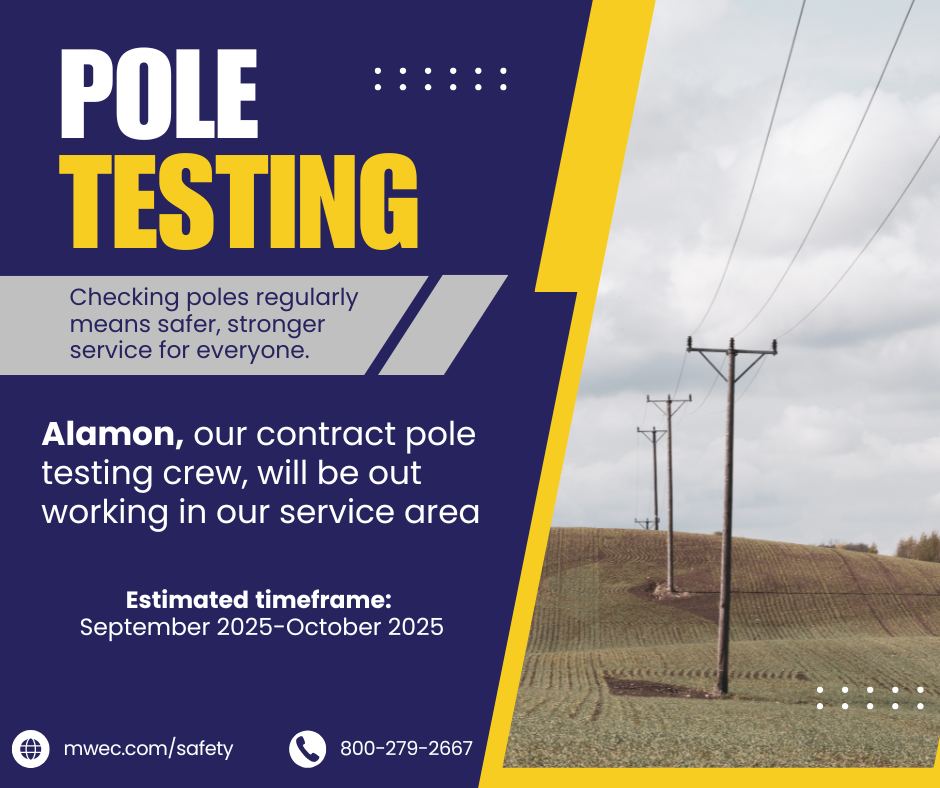SAFETY TIPS
At Mountrail-Williams Electric Cooperative (MWEC), our dedication lies in ensuring the safety and efficiency of our work to safeguard both members and employees. We are dedicated to empowering you through education and community outreach, providing an array of safety tools, resources, and programs.
Whether dealing with electricity within your home or in outdoor settings, prioritizing safety should always be paramount.
Pole Testing

MWEC conducts regular pole inspections to help ensure the safety and reliability of our systems infrastructure. This allows us to identify potential problems and proactively address them, keeping your power safe and reliable.
Tree Trimming

Trees are majestic, beautiful, and good for the soul. But we also know that our members depend on us to deliver reliable power to their homes and businesses. That’s why Mountrail-Williams Electric Cooperative (MWEC) strives to balance maintaining the beautiful surroundings we all cherish with ensuring reliable electricity. You might not realize it, but there are several benefits to regular tree trimming.
*Only the vegetation within the MWEC right-of-way/easement areas will be trimmed or removed.
Benefits of Tree Trimming
“Keeping power lines clear of overgrown vegetation improves service reliability,” Operations Manager Matt Glueckert says, “After all, we’ve seen Mother Nature during severe weather events with fallen tree limbs taking down power lines and utility poles.” While many factors can impact power disruptions, about half of all outages can be attributed to overgrown vegetation. This is why you sometimes see our crews or contractors out in the community trimming trees near power lines. Our trimming crews have been trained and certified based on the latest industry standards.
In fact, all U.S. electric utilities are required to trim trees that grow too close to power lines. Scheduled trimming throughout the year keeps lines clear from overgrown or dead limbs that are likely to fall, and we are better able to prepare for severe weather events.
Plus, we all know it’s more cost-effective to undertake preventative maintenance than it is to make repairs after the fact. Future drone inspections of power lines and vegetation will allow us to reduce labor and equipment costs while bolstering reliability. Through the use of small drones, the health and growth of trees can be accurately monitored to identify potential problems.
Working near power lines can be dangerous, and we care about your safety and that of our lineworkers. For example, if trees are touching power lines in our members’ yards, they can pose a grave danger to families. If children can reach those trees, they can pose a danger. Electricity can arc, or jump, from a power line to a nearby conductor such as a tree.
Any tree or branch that falls across a power line creates a potentially dangerous situation. A proactive approach lessens the chances of fallen trees during severe weather events that make it more complicated and dangerous for lineworkers to restore power.
As a co-op, MWEC always strives to keep costs down for our members. If trees and other vegetation are left unchecked, they can become overgrown and expensive to correct. A strategic vegetation management program helps keep costs down for everyone.
When it comes to vegetation management, there are ways you can help too. When planting new trees, make sure they’re planted a safe distance from overhead power lines. Medium-height trees (40 ft. or smaller) should be planted at least 25 ft. from power lines. Taller trees (over 40 ft.) should be planted at least 50 ft. from power lines. You can also practice safe planting near pad-mounted transformers. Plant shrubs at least 10 ft. from the transformer door and 4 ft. from the sides. If your neighborhood has underground lines, remember to contact 811 before you begin any project that requires digging.
Additionally, if you spot an overgrown tree or branch that’s dangerously close to overhead lines, please let us know by contacting our office at 800-279-2667.
Don't Be Spoofed
Calling and asking for personal and financial information is a common tactic used by scammers. It’s important to always be cautious and not share any sensitive information with unknown callers. If you receive such calls, consider taking the following steps:
Don’t Share Personal Information: Avoid providing personal or financial information over the phone. MWEC will never call requesting credit/debit card or banking information.
Question your Caller ID: Be cautious if the caller’s number is hidden or if the caller ID seems suspicious. Scammers often use techniques like caller ID spoofing to appear as if they’re calling from a trusted source.
Report Scams: If you receive a call from a claimed MWEC sourced that you believe to be a scam, report it to your local authorities and your local MWEC office.

Block and Ignore: Consider blocking the number if you receive repeated scam calls from the same source. Ignore calls from unknown numbers and let them go to voicemail.
Educate Yourself: Stay informed about common scams and tactics used by scammers. Awareness can help you recognize potential threats.
Don’t be spoofed. If you’re uncertain about a call’s legitimacy, hang up and call Mountrail-Williams Electric Cooperative directly at 1.800.279.2667.
